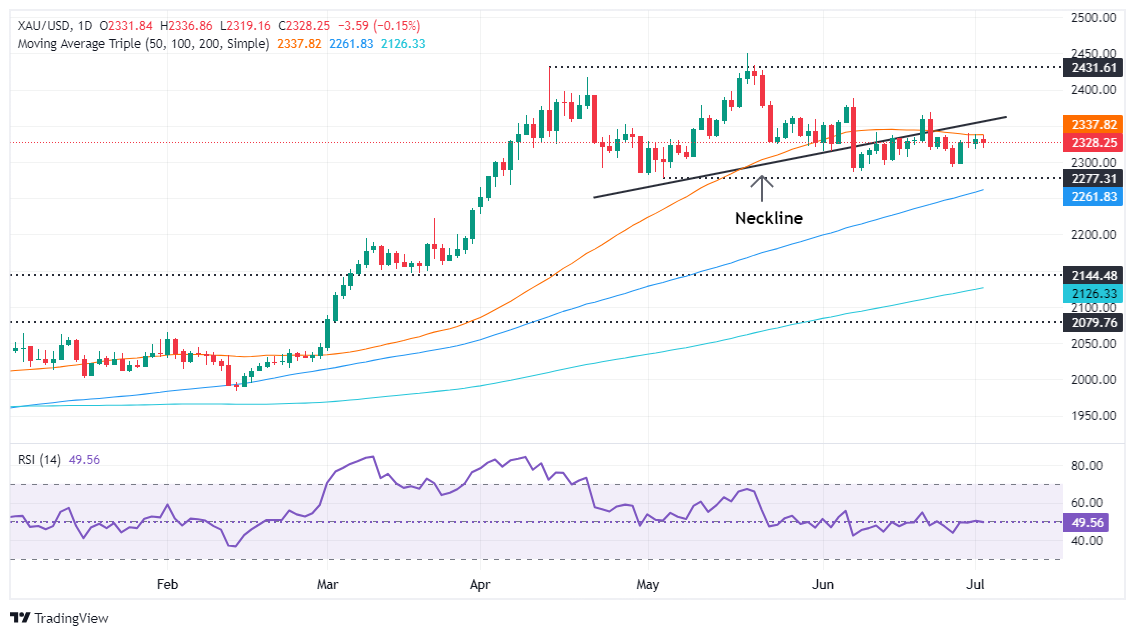Gold falls amid falling US yields, soft US Dollar
- Gold falls 0.28%, reacting to Powell’s ECB forum remarks.
- Powell is cautiously optimistic on disinflation, emphasizes need for more progress before rate cuts.
- US Treasury yields steady, while US Dollar fluctuates in familiar range.
- Strong US labor data: Job vacancies exceed expectations, highlighting economic resilience.
Gold price slid during the North American session as market participants digested Federal Reserve (Fed) Chair Jerome Powell’s comments at a European Central Bank (ECB) forum in Portugal. Powell turned slightly dovish, yet US Treasury yields remained firm. The Greenback fluctuated but remained within familiar levels. Therefore, the XAU/USD trades at $2,324, down 0.28%.
Powell commented that the disinflation process has resumed yet stated that he’d like to see further progress before cutting interest rates. He added, “Because the US economy is strong and the labor market is strong, we have the ability to take our time and get this right.”
He acknowledged the Fed’s dual mandate risks had become more balanced, noting that “we have to manage them.”
US jobs data revealed that job vacancies surprisingly rose above estimates, displaying the robustness of the labor market amid high interest rates of 5.25%-5.50% set by the Fed.
Further data is expected on Wednesday, led by the release of the Federal Open Market Committee's (FOMC) last Meeting Minutes, alongside Services PMIs from S&P Global and the Institute for Supply Management (ISM).
Data will resume on Friday as US markets will be closed on Thursday due to Independence Day. By Friday, traders will be focused on June’s Nonfarm Payrolls (NFP) report.
Daily digest market movers: Gold price retreats below $2,330 amid strong JOLTS data
- US Bureau of Labor Statistics released May Job Openings and Labor Turnover reports, which showed 8.14 million job vacancies, exceeding forecasts and April’s 7.919 million, the lowest level in three years.
- US business activity in the manufacturing sector showed mixed results. Traders are now focusing on the upcoming release of service sector data on Wednesday.
- According to the CME FedWatch Tool, odds for a 25-basis-point Fed rate cut in September are at 63%, up from 58% on Monday.
- December 2024 fed funds rate futures contract implies that the Fed will ease policy by just 36 basis points (bps) toward the end of the year.
Technical analysis: Gold price fluctuates nearby Head-and-Shoulders neckline
Gold is upwardly biased but consolidates near the Head-and-Shoulders neckline around $2,320-$2,350. Despite the bearish chart pattern, momentum has turned neutral with the Relative Strength Index (RSI) nearing its 50-neutral line. That indicates a stalemate between buyers and sellers.
For a bearish continuation, sellers must drive prices below $2,300. If successful, the next demand zone would be the May 3 low of $2,277, followed by the March 21 high of $2,222. Further declines would target the Head-and-Shoulders pattern objective between $2,170 and $2,160.
Conversely, if buyers break through $2,350, they would aim for key resistance levels, such as the June 7 cycle high of $2,387, eventually targeting the $2,400 mark.

Gold FAQs
Gold has played a key role in human’s history as it has been widely used as a store of value and medium of exchange. Currently, apart from its shine and usage for jewelry, the precious metal is widely seen as a safe-haven asset, meaning that it is considered a good investment during turbulent times. Gold is also widely seen as a hedge against inflation and against depreciating currencies as it doesn’t rely on any specific issuer or government.
Central banks are the biggest Gold holders. In their aim to support their currencies in turbulent times, central banks tend to diversify their reserves and buy Gold to improve the perceived strength of the economy and the currency. High Gold reserves can be a source of trust for a country’s solvency. Central banks added 1,136 tonnes of Gold worth around $70 billion to their reserves in 2022, according to data from the World Gold Council. This is the highest yearly purchase since records began. Central banks from emerging economies such as China, India and Turkey are quickly increasing their Gold reserves.
Gold has an inverse correlation with the US Dollar and US Treasuries, which are both major reserve and safe-haven assets. When the Dollar depreciates, Gold tends to rise, enabling investors and central banks to diversify their assets in turbulent times. Gold is also inversely correlated with risk assets. A rally in the stock market tends to weaken Gold price, while sell-offs in riskier markets tend to favor the precious metal.
The price can move due to a wide range of factors. Geopolitical instability or fears of a deep recession can quickly make Gold price escalate due to its safe-haven status. As a yield-less asset, Gold tends to rise with lower interest rates, while higher cost of money usually weighs down on the yellow metal. Still, most moves depend on how the US Dollar (USD) behaves as the asset is priced in dollars (XAU/USD). A strong Dollar tends to keep the price of Gold controlled, whereas a weaker Dollar is likely to push Gold prices up.